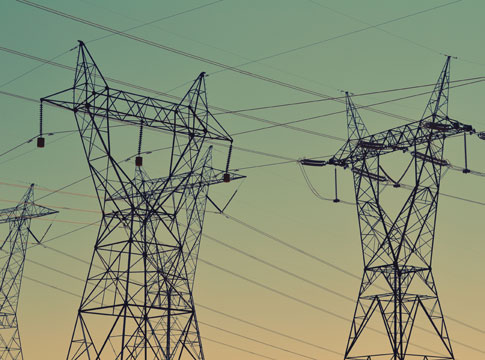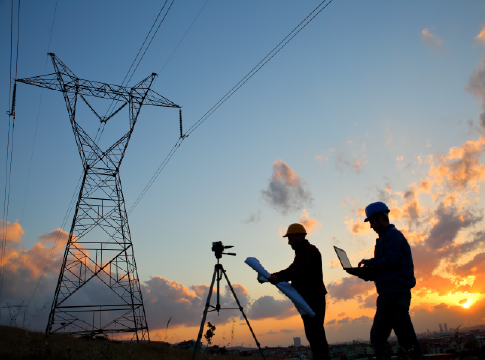Related News
Related News
-
Energy conservation could offset large portion of growth in power demand
Preliminary results of an EWEB study indicate that cutting back demand can contribute to maintaining a reliable, affordable energy supply.
Find Out More -
Groups suing EWEB will burden customers with litigation-driven costs
EWEB expresses disappointment that groups choose court over collaboration and firmly disputes the claims made in the lawsuit relating to operation of the utility’s Carmen-Smith Hydroelectric Project nearly 70 miles east of Eugene. EWEB takes its environmental and public safety responsibilities seriously. Contrary to the assertions in the lawsuit, construction of fish passage was postponed because EWEB’s regulator, the Federal Energy Regulatory Commission (FERC), required the utility to study and resolve urgent dam safety issues first.
Find Out More -
Rising Together: Female operation staffers begin industry mentorship program
One week into Women's History Month and just before International Women's Day on March 8, three women in EWEB leadership roles embarked on a 10-month-long journey of mentorship, fellowship, and professional development.
Find Out More -
PNW Lineman Rodeo raises $85,000 for Oregon Burn Center
EWEB line techs are proud partners and participants in the rodeo fundraiser every year.
Find Out More -
Energy demand reaches highest level in nearly a decade as utility prepares for ice
Frigid temperatures in the low 20s caused surging electricity demand in early February.
Find Out More -
Frigid weather drives highest energy demand of the winter so far
Peak electricity demand this season surpasses demand levels during last year’s ice storm.
Find Out More -
Recovery still ongoing on the anniversary of the 2024 Ice Storm
Cost of rebuilding EWEB's electrical system will surpass $11 million
Find Out More -
EWEB awarded $1 million for wildfire resiliency projects from Federal funding package
Funds will be used to support fuels reduction work on a landscape scale in high-risk areas in the McKenzie River Valley and Eugene South Hills.
Find Out More -
Your Rates at Work: Investing Today for a Resilient Tomorrow
For more than a century, EWEB has planned, built, and maintained the systems that deliver safe, reliable, and environmentally responsible power and water to Eugene homes and businesses.
Find Out More -
EWEB hires firm behind decommissioning Klamath dams for Leaburg support
EWEB selects McMillen, Inc. to lead Leaburg project decommissioning, pointing to firm’s experience keeping nation’s largest-ever decommissioning project on-time and under budget.
Find Out More -
EWEB Board Approves 2025 Budget and Rate Increases to Fund Critical Infrastructure Investments
EWEB’s budget is less than initially projected while still addressing aging infrastructure and rising costs to ensure reliable utility services for Eugene.
Find Out More -
Celebrating the new Currin Substation
After two years of rebuilding the substation, EWEB honors the Currin Substation with a ribbon-cutting.
Find Out More -
Public Power Week Poster Contest Winners 2024
The results are in! View the winning posters from EWEB's 2024 Public Power Week Poster Contest.
Find Out More -
2024 Public Power Week Poster Contest
To celebrate Public Power Week, EWEB is held our annual poster contest for fifth graders in our service area. Help us choose the winners.
Find Out More -
EWEB prepares to re-energize the new Currin Substation
The rebuilt substation will increase load capacity, improve power reliability, and incorporate seismic resiliency to ensure service to our community for generations.
Find Out More - Show More
Demand for EWEB electricity during heatwave nearly broke all-time summer record
July 15, 2024 • Aaron Orlowski, EWEB Communications

The heatwave culminating on July 9 pushed electricity demand in EWEB's service territory to the second-highest level ever during the summer.
It's a preview of the future, with climate-driven weather extremes, home electrification, high-tech manufacturing and data centers all forecasted to cause electricity demand to surge across the Pacific Northwest in the years ahead.
Temperature is the biggest driver of electricity demand, and the heatwave’s searing temperatures – five days straight over 100 degrees – reflect that.
On Tuesday, July 9, temperatures hit 105 degrees and electricity demand peaked at 418 megawatts at 6 p.m. – the second highest summer day for electricity demand ever for EWEB. Monday, July 8, when temperatures maxed out at 104 degrees, nearly matched that demand with a peak of 416 megawatts at 6 p.m.
Demand during this heatwave was about 3% higher than similar heat waves in 2023 and 2021, when temperatures also rose above 100 degrees for multiple days.
The only summer day that had higher electricity demand was in 2006, when there was an additional large industrial consumer in Eugene that consumed large amounts of electricity – the Hynix microchip manufacturing plant. That year, on Monday, July 24, temperatures hit 100 degrees and electricity demand topped out at 423 megawatts.
The Hynix plant opened in 1998 and closed 10 years later due to a downturn in the market for microchips. The closure of the plant, and concurrent economic recession, prompted a steep drop in electricity demand in Eugene. Since then, overall demand has stayed relatively flat while peak demand on the hottest days of the year appears to be creeping up.
"As summers get hotter, air conditioning use will only rise in our community," said EWEB Chief Energy Resources Officer Brian Booth. "We’ve made it through the last couple decades by using energy efficiency to cut energy usage at the same rate that it’s rising. But demand is starting to outpace our ability to implement conservation programs, and we will soon need new sources of on-demand, dispatchable electricity to keep up."
Climate change is intensifying heatwaves – and energy demand.
In Eugene, days with temperatures above 100 degrees used to be rare. According to records from the National Oceanic and Atmospheric Administration (NOAA), 2015 was the year with the most 100-degree days, with seven of them. Already in 2024, there have been five days above 100 degrees – and it’s only July.
Climate change will cause more heatwaves in the years ahead.
Oregon’s summers are already 3 to 4 degrees warmer than in pre-industrial times, Oregon’s state climatologist told OPB. Before the 2020s, heatwaves with 100-plus degree temperatures happened once every 10 to 20 years. But those kinds of heatwaves have struck Oregon in three of the last four summers.
In the past, summer demand rarely if ever topped 400 megawatts, while average demand lingered around 250 megawatts. In general, meeting winter demand is much more challenging, with peaks reaching at least 25% higher than in the summer. Winter peaks reach as high as 500 or even 550 megawatts, and averages hover near 300 to 350 megawatts. But summer peaks strain the distribution system more as wires sag from heat and transformers struggle to dissipate heat.
"Meeting electricity demand on mild or even warm days is relatively simple. If demand for electricity were always at average levels, our task of delivering reliable, affordable and environmentally responsible power would be easy," Booth said. "It’s the peaks that are challenging, and they are what we plan our system around. That’s why we need energy resources – like hydropower – that can generate on demand."
Flexible hydropower resources keep costs low for EWEB customers.
To keep costs down during the heatwave, EWEB relied on its flexible hydropower resources – especially its Carmen-Smith Hydroelectric Project on the McKenzie River and the flexible portion its allotment of Columbia River hydropower sold by the Bonneville Power Administration (BPA).
During this heatwave, EWEB bought energy on the wholesale market when it was cheap during the cooler hours of the day, then ramped up production at its hydropower facilities during the hot evening hours, avoiding pricey market purchases.
During the coolest, lowest demand hours of the day on Monday and Tuesday – from about midnight to 7 a.m. – real-time wholesale energy prices were just over $20 per megawatt-hour. But at peak moments, prices reached nearly $250 per megawatt-hour.
"Wholesale electricity prices are always changing, but they become especially volatile during extreme weather events like this past heatwave," said Chad Hadley, an EWEB power trader. "EWEB takes cues from these volatile price signals to guide when we dispatch our on-demand hydropower resources. We’re fortunate to have these resources because they allow us to minimize our exposure to the market and ultimately keep costs low for customers."
Electricity demand in the Pacific Northwest forecasted to rise 30% in the next 10 years.
Data centers, high-tech manufacturing, electrification of heating and cooling, and adoption of electric vehicles will cause demand for electricity in the Pacific Northwest to climb 30% in the next decade, according to the Pacific Northwest Utilities Conference Committee’s (PNUCC’s) 2024 regional forecast, which was published in May. The report compiles the demand forecasts of utilities across the Northwest into one comprehensive number.
This surge in electricity demand is the equivalent of adding about seven cities the size of Seattle to the Northwest power grid. And the demand forecast is likely on the low end: It doesn’t include some demand from data centers that large tech companies are building.
While Northwest utilities continue to add new resources to replace the retirement of carbon-emitting resources, they haven’t done so at a rate sufficient to meet anticipated demand, the report says.
In the next 10 years, if utilities don’t build any new resources, then the region will face massive shortages of electricity on the hottest summer days and the coldest winter days. The report forecasts a deficit of 13,700 megawatts in the next decade in both summer and winter if demand rises as expected and if utilities don’t build any additional resources.
"While individual utilities have unique needs, there is a shared commitment to collaboration in developing an unprecedented amount of new generation in the next 10 years," PNUCC Executive Director Crystal Ball said in a statement. "This will require intense coordinated planning along with strong public support to assure an adequate, reliable power supply during the region’s transition to a cleaner energy future."
Shortages could arrive as soon as 2027 in the Pacific Northwest.
Weather drives demand for electricity. Hot weather will elevate the risk of blackouts in much the country this summer, including California and the desert Southwest, according to the North American Electric Reliability Corporation’s (NERC’s) 2024 Summer Reliability Assessment. The assessment states that the Northwest has enough resources to meet demand this summer.
But in the years ahead, the specter of electricity shortages looms, experts warn. As heat waves grow more frequent and weather grows more extreme, electric utilities will need to build additional electricity generation facilities to keep up with demand. If they don’t do so in the next 20 years, industry studies say, electricity shortfalls could occur, leading to rolling blackouts.
One study, conducted by the Western Electricity Coordinating Council (WECC), forecasts what would happen during a heat wave in the year 2042 if demand for electricity rises as expected and if buildout of new resources occurs as utilities are currently planning. In this “business as usual” future, a heat wave similar to the heat wave that struck in August 2020 will inflict blackouts on the Western U.S.
Another study says those shortages could arrive in just a few years, if the region doesn’t take action.
If the Pacific Northwest does not build any additional new energy resources, the region faces a nearly 50% chance of blackouts at some point in 2027 due to insufficient energy, according to a new report published by the Northwest Power and Conservation Council (NWPCC).
In stark terms, the report makes clear that the region’s current power supply will not be enough to meet demand in 2027, if the region tries to rely solely on existing resources. Instead, the report says, the region needs to obtain at least the amount of energy outlined in NWPCC’s 2021 Power Plan.
The new report finds that if the region follows the 2021 Power Plan resource strategy and builds a large number of new resources, it will effectively eliminate nearly all potential shortfalls of energy during the summer. But acquiring the resources suggested in the 2021 Power Plan still won’t be sufficient to eliminate winter shortfalls, when there may not be enough energy to meet needs during certain hours on the coldest days of the year.
Market dynamics and new policies are likely to make the need for new resources even greater.
"If future electricity market supplies are significantly limited, if new policy commitments to electrification accelerate demand growth, or if major resources are retired earlier than expected without replacement, then additional resources and reserves will be required to maintain system adequacy," the report says.
Customer participation will be vital to meeting future needs
Utilities, including EWEB, will need to either procure new sources of electricity that they can call upon on a moment’s notice to generate more power, or find ways to pare back electricity demand when it’s at its highest.
Last summer, during the August heat wave that saw temperatures crest 100 degrees for four days straight, EWEB called on customers to voluntarily trim their energy usage in the late afternoon and evening hours to avoid straining the grid.
Customers responded by raising the setting on their thermostats a couple degrees and delaying usage of major appliances until overnight, ultimately shaving energy usage by 10 to 15 megawatts during certain hours, or the equivalent of shutting off 10,000 to 15,000 window air conditioning units across Eugene.
Since then, EWEB has been studying instituting formalized “demand response” programs that would reward customers for cutting energy usage at peak times. Specifically, EWEB is analyzing what types of programs will yield the most energy savings for the investment and which will have the highest potential adoption rates.
"During the 2023 heat wave, we had a tremendous response from our community. People rallied together to cut back energy usage when we needed to and achieve something that no one could have done alone," Booth said. "The enthusiasm makes me excited to see how demand response programs can play an increasingly important role in our efforts to better align electricity demand with supply."
Related Programs
EWEB’s Integrated Resource Plan (IRP) will analyze possible energy resource portfolios with a goal of creating useful insights for long-term (20-year) electricity supply planning decisions.




